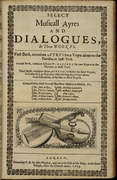Caught the Catch?
Kristina Krämer
Thursday, November 14, 2019

While revising the many anthologies published by John Playford starting around 1650 (titles ranging from Catch that Catch Can and Musicks Recreation to Select Ayres and Dialoges) the entry for B/I 1653|7 (Select Musicall Ayres and Dialogues […] Printed by T[homas] H[arper] for John Playford) stood out because the British Library’s digitised copy (GB-Lbl F.51.b) turned out to be a curious one: the missing printed title page has been replaced by a handwritten one. However, the handwritten title page mimics the printed page so accurately that you could easily mistake it for the printed one. Closer inspection shows that the writer probably wasn’t a trained, professional scribe. In the upper right corner, for example, someone started copying the ornamental frame as well but stopped quite soon (possibly regarding it as a futile undertaking). The pencil marks that outline the rest of the frame remain. The much too slanted word “Ayres” in the seventh line is also noticeable.
Another peculiar aspect is the vignette featuring a lute, theorbo and music. Here, one might suspect that the scribe cut it out of another copy of this print and glued it onto the title page. The vignette was indeed glued to the page—however, like the rest, it is handwritten. Indications of this are that, for example, the lily is placed a bit too low in one corner and some leaves in the wreath are missing veins. Furthermore, our writer made mistakes copying the music: a clef was added, the second note is a D even though it should look more like an E, the note heads of the second and third note shouldn’t be filled in and in the third bar there obviously wasn’t enough space for a second note. So far we haven’t been able to identify the notated song. Any clues are very welcome.
When, by whom and why could this title page have been replaced? It presumably happened not too long after the anthology’s publication, while it was still fresh and used by musicians. It is possible that the printed title page was heavily damaged or even lost. Using the damaged page or a borrowed copy of the book as a model, our scribe could have copied the title in detail.
Both the binding and marbled flyleaves (which weren’t widely used until the 18th century) date from a later period, especially as it is highly unlikely that the copyist was a member of the Order of the Garter (see the coat of arms on the book cover) or that such a member entrusted the task to a diligent but not professional writer. By the way, there are a number of books in the British Library’s collection whose covers feature the symbol of the Order of the Garter. In one case the binding and flyleaves look almost identical to F.51.b: the copy of Johann Wolfgang Franck’s Remedium melancholiæ (A/I F 1623; GB-Lbl G.90.). Which member of the Order might have owned these books?
Did you notice any other special aspects? Or do you know of similar cases?
Image: Title page of GB-Mr 1408 (this copy has already been added to RISM and will be visible after the next catalog update) and the title page of GB-Lbl F.51.b.
Share Tweet EmailCatégorie: Nouveau au RISM

